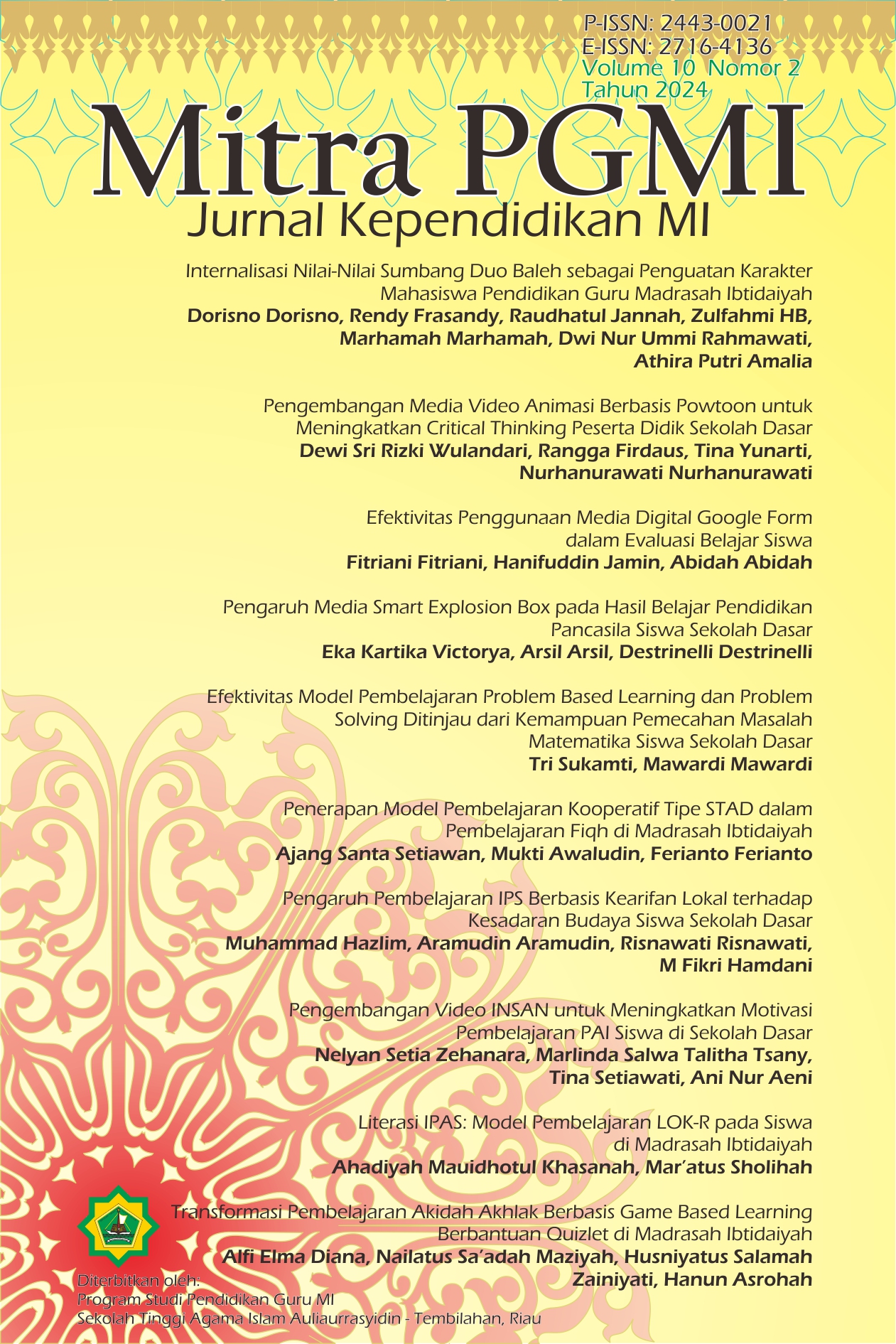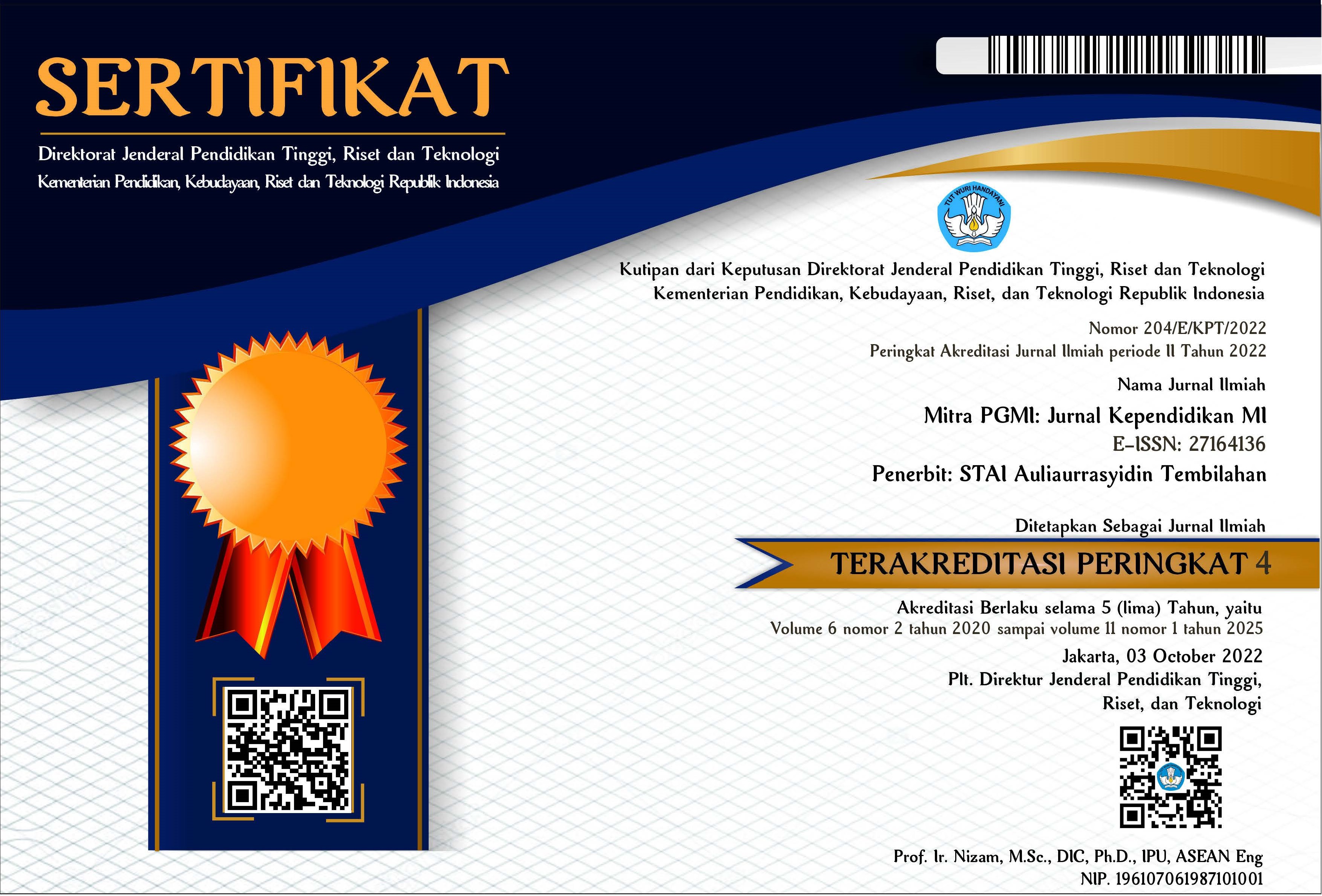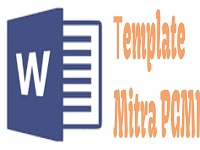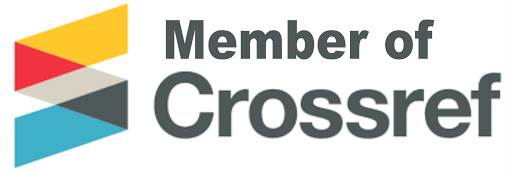Pengembangan Media Video Animasi Berbasis Powtoon untuk Meningkatkan Critical Thinking Peserta Didik Sekolah Dasar
DOI:
https://doi.org/10.46963/mpgmi.v10i2.1817Keywords:
Critical Thinking, Animated Video, Media, PowtoonAbstract
This research aims to develop Powtoon-based animation videos to improve students' critical thinking. The research method uses ADDIE which consists of five stages: Analysis, Design, Development, Implementation, and Evaluation. The research sample was class IV A as the experimental class and IV B as the control class. The results of the study include the feasibility, practicality, and effectiveness of the product. The feasibility of the product is considered valid based on the validation results, with an average Aiken index of 0.808 for material, 0.958 for language, and 0.608 for media. The practicality of the product was seen from the responses of educators (90%) and students (89%), both of which were interpreted as very practical. The effectiveness of the product was measured through a comparison of the improvement of critical thinking skills between the experimental and control classes. The results show that the experimental class has an effect size value of 0.798, which is interpreted as high. This proves that the use of Powtoon-based animated videos significantly improves critical thinking skills compared to those who do not use the product.
Downloads
References
Apriansyah, M. R. (2020). Pengembangan Media Pembelajaran Video Berbasis Animasi Mata Kuliah Ilmu Bahan Bangunan di Program Studi Pendidikan Teknik Bangunan Fakultas Teknik Universitas Negeri Jakarta. Jurnal PenSil, 9(1), 9–18. https://doi.org/10.21009/jpensil.v9i1.12905.
Astika, R. Y., Anggoro, B. S., & Andriani, S. (2019). Pengembangan video media pembelajaran matematika dengan bantuan powtoon. Jurnal Pemikiran Dan Penelitian Pendidikan Matematika, 2(1), 85–96. https://journal.rekarta.co.id/index.php/jp3m/article/view/214
Awalia, I., Pamungkas, A. S., & Alamsyah, T. P. (2019). Pengembangan Media Pembelajaran Animasi Powtoon pada Mata Pelajaran Matematika di Kelas IV SD. Kreano, 10(1), 49– 56. https://doi.org/10.15294/kreano.v10i1.18534.
Fajar, S., Riyana, C., & Hanoum, N. (2017). Pengaruh Penggunaan Media Belajar PowToon pada Mata Pelajaran Ilmu Pengetahuan Terhadap Hasil Sosial Terpadu. Edutcehnologia, 3(2), 101–114. https://ejournal.upi.edu/index.php/edutechnologia/article/view/8957
Garsinia, D., Kusumawati, R., & Wahyuni, A. (2020). Pengembangan Media Pembelajaran Video Animasi Menggunakan Software Powtoon pada Materi SPLDV. Jurnal Riset Pendidikan Dan Inovasi Pembelajaran Matematika, 3(2), 44–51. https://doi.org/10.26740/jrpipm.v3n2.p44-51
Hendi, A., Caswita, & Haenilah, E. Y. (2020). Pengembangan Media Pembelajaran Interaktif Berbasis Strategi Metakognitif untuk Meningkatkan Kemampuan Berpikir Kritis Siswa. Jurnal Cendekia: Jurnal Pendidikan Matematika, 4(2), 823–834. https://doi.org/10.31004/cendekia.v4i2.310
Isti, L. A., Agustiningsih, A., & Wardoyo, A. A. (2022). Pengembangan Media Video Animasi Materi Sifat-Sifat Cahaya untuk Siswa Kelas IV Sekolah Dasar. EduStream: Jurnal Pendidikan Dasar, 4(1), 21–28. https://doi.org/10.26740/eds.v4n1.p21-28.
Kivunja, C. (2014). Teaching Students to Learn and to Work Well with 21 Century Skills: Unpacking the Career and Life Skills Domain of the New Learning Paradigm. Internasional Journal of Higher Education, 4(1), 1–11. http://dx.doi.org/10.5430/ijhe.v4n1p1
Mashuri, D. K., & Budiyono. (2020). Pengembangan Media Pembelajaran Video Animasi Materi Volume Bangun Ruang untuk SD Kelas V. JPGSD: Jurnal Pendidikan Guru Sekolah Dasar, 8(5), 893–903. https://ejournal.unesa.ac.id/index.php/jurnal-penelitian-pgsd/article/view/35876
Megawati, M. da. M. S. (2021). Menjadi Guru Yang Kreatif Dan Inovatif Di Masa Depan (pp. 1–6). https://doi.org/http://digilib.unimed.ac.id/43385/
Mirawati, N., Balkist, P. S., & Setiani, A. (2021). Pengembangan Media Pembelajaran Berbasis Video Menggunakan Powtoon dan Movavi Video Editor Terhadap Kemampuan Berpikir Kritis Siswa. De Fermat: Jurnal Pendidikan Matematika, 4(1), 94–100. https://jurnal.pmat.uniba-bpn.ac.id/index.php/DEFERMAT/article/view/87
Mite, Y., & Corebima, A. D. (2017). The Correlation Between Critical Thinking and The Learning Results of The Senior High School Students in Biology Learning Implementing Group Investigation (GI) Learning in Malang, Indonesia. Journal of Applied and Advanced Research, 2(2), 56–62. http://dx.doi.org/10.21839/jaar.2017.v2i2.57
Nugroho. (2020). Pengembangan Produk Bermedia Powtoon Untuk Materi Cerita Pendek Kelas XI MIPA 2 SMA Pangudi luhur Sedayu. Tesis. Sanata Dharma University.
Purwati. (2016). Analisis Kemampuan Berpikir Kritis Dalam Menyelesaikan Masalah Persamaan Kuadrat pada Pembelajaran Model Creative Problem Solving. Jurnal Kadikma, 7(1). https://doi.org/10.19184/kdma.v7i1.5471.
Sholihah, M., & dkk. (2016). REMAP RT (Reading Concept Map Reciprocal Teaching) to Enhance Student’s Critical Thinking Skills. Proceeding Biology Education Conference, 13(1), 280–284. https://jurnal.uns.ac.id/prosbi/article/view/5720
Wuryanti, U., & Kartowagiran, B. (2016). Pengembangan Media Video Animasi Untuk Meningkatkan Motivasi Belajar Dan Karakter Kerja Keras Siswa Sekolah Dasar. Jurnal Pendidikan Karakter, 6(2), 232–245. https://doi.org/10.21831/jpk.v6i2.12055
Downloads
Published
Issue
Section
License
Copyright (c) 2024 Dewi Sri Rizki Wulandari, Rangga Firdaus, Tina Yunarti, Nurhanurawati Nurhanurawati

This work is licensed under a Creative Commons Attribution-ShareAlike 4.0 International License.
Authors who publish with this journal agree to the following terms:
1. Copyright on any article is retained by the author(s).
2. The author grants the journal, right of first publication with the work simultaneously licensed under a Creative Commons Attribution shareAlike 4.0 International License that allows others to share the work with an acknowledgment of the work’s authorship and initial publication in this journal.
3. Authors are able to enter into separate, additional contractual arrangements for the non-exclusive distribution of the journal’s published version of the work (e.g., post it to an institutional repository or publish it in a book), with an acknowledgment of its initial publication in this journal.
4. Authors are permitted and encouraged to post their work online (e.g., in institutional repositories or on their website) prior to and during the submission process, as it can lead to productive exchanges, as well as earlier and greater citation of published work.
5. The article and any associated published material is distributed under the Creative Commons Attribution-ShareAlike 4.0 International License








2.png)


